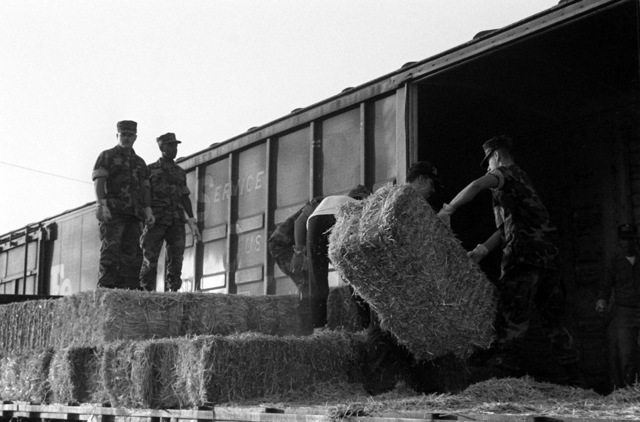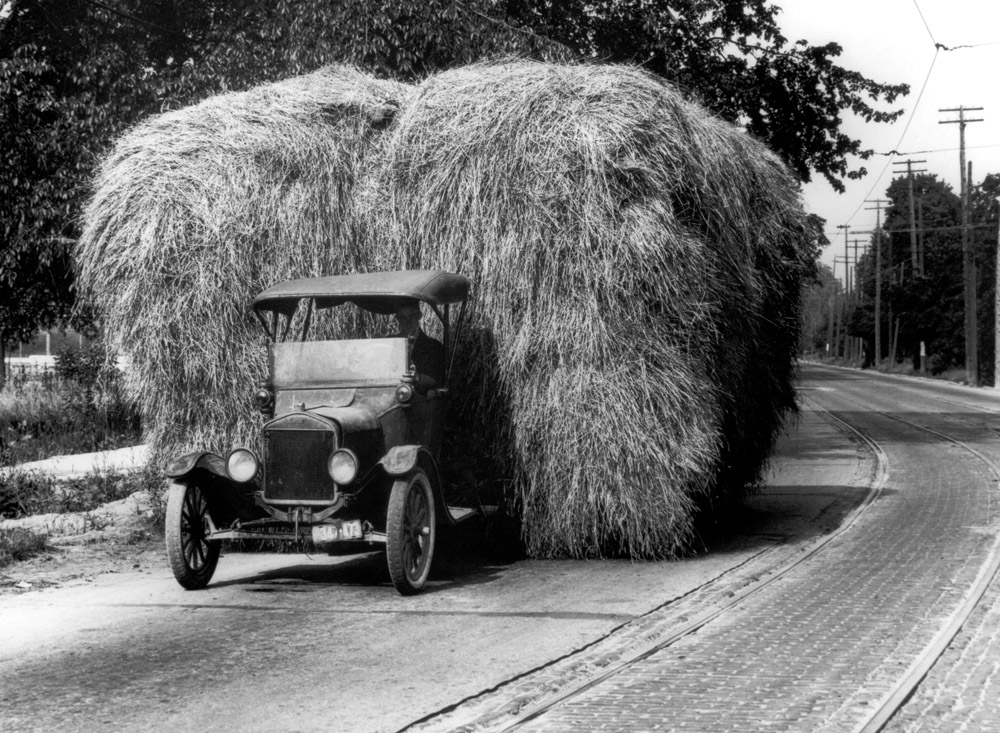Something y’all might enjoy: http://www.railpictures.net/photo/690793 “Remarks & Notes … San Luis & Rio Grande wanted to capitalize on some of the hay that is trucked out of the valley and delivered out of state. A 89-foot flatcar (FEC No. 3332) was equipped with bulkhead ends, and the car loaded with hay. As anyone knows that has followed a pickup truck loaded with hay, it’s a pretty unstable load. …”
The would have had better luck using a center-beam flat. At least then they would have had something solid to strap the load to.
Ground looks damp, I suspect a rain made the load shift to center and sag some as well. A tarp would have been prudent, but would hide the thought…
First, I have never seen hay bales that large. Those appear to be near chord size (4 x 4 x 8 ft). The issue I see is that they should have 'woven' the bales. I lived in rural Tennessee for a good while, and watched farmer load hay wagons with baled hay and run down curvy paved over cow paths and never loose a bale. Yes, the bales I saw were much smaller, but the principal is the same. In this case I would suggest loading like this
https://www.largescalecentral.com/FileSharing/user_2060/General%20Pics/HalfBasket.jpg
I can't seem to get my freightshed pics to display, copy/paste the into the url bar.
Rotate the picture 180 degrees for the next layer. This interlocks each layer to the layer below stabilizing the load.
Bob,
Out here in Eastern WA, farmers bale hay in bales like that and even bigger. Never seen it hauled on trains, just trucks.
Most of it in those large bales, goes to the coast and is put in containers for shipping to japan or China. They would rather load
a few bigger bales in a container than lots of normal size bales.
They have bales that size in the field behind me. Ain’t sure what the farmer uses them for, but earlier he was making round bales that were loaded onto a truck. They may sell them to the compost places around here.
My thoughts on hauling hay by rail.
Modern.


Down under in Queensland

Civil War

DRGW standard guage


Southern Pacific using boxcars.

My model which is based on the DRGW supplying hay for annual sheep movements to high pastures. They often loaded hay bales into empty stock cars for transport to winter silage.

and just because…

…because grand-pa did it this away.

hmm… railpictures won’t let you see pictures any more unless your ad blocker is off…
if you are fast, right click on the picture and select view image…
Humm weird… I thought it showed up for me, but I guess not. Oh well.
not visible to me, with and without the s…
Greg
Greg Elmassian said:
not visible to me, with and without the s…
Greg
More than one way to skin a cat… Download, and upload to flickr…

on my ranch we made hay in rectangular bales during about 15 years or more.
the only pics with a stable load shown are that of the Southern Pacific and the one with that pick-up on the highway.
I have hauled the big and the normal bales of hay, the small bales are best with an alternating layers to hold them in place, and the big bales will ride on a flatbed stacked 3 high with 1 or 2 straps on each stack with little or no worry’s about shifting. I have hauled them 2 bales across the whole load, and have hauled them stacked across the trailer with no alternating rows.
trains are a little less stable side to side with rocking that can cause some shifting, it looks to me like the only problem was a slight shifting ( or bad loading, not pushing them straight, on the center stack) but the load looks stable and to me would probably ride well. Yes they overdid the straps, and if they were really worried about shifting , turning the second or third row across the car would lock the load down much better. I am betting that car was shipped with no problems after someoneput a couple of straps on that center stack
on a side note most of the hay I have hauled, the loaders ( usually an independent person or service) pride themselves in flat up and down loads that could pass for a box trailer.
For ever since I can remember small bale hay loads in Calif. where I grew up , the only securement for them was 2 1-2” thick ropes from front to back on double trailers, with no side to side ropes at all, and that is legal in a state with some strict tiedown rules for everything
Bob Cope said:

